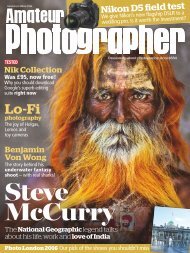You also want an ePaper? Increase the reach of your titles
YUMPU automatically turns print PDFs into web optimized ePapers that Google loves.
Antoniadi, who had<br />
worked as an assistant<br />
to Flammarion<br />
at Juvisy from 1893<br />
to 1902, made the<br />
critical observations.<br />
Sci-fi inspiration<br />
Nevertheless, Lowell’s and Flammarion’s<br />
visions of Mars had sparked imaginations.<br />
H. G. Wells relied on the model of Mars<br />
as a dying planet of advanced engineers in<br />
describing his conquering octopus-men in<br />
The War of the Worlds (1898). Following<br />
Flammarion, Edgar Rice Burroughs had<br />
his hero John Carter astrally transport to<br />
Mars — or Barsoom, as the locals called it<br />
— in A Princess of Mars (1912).<br />
Burroughs’ novels and the pulp science<br />
fiction that followed inspired many budding<br />
scientists. Carl Sagan, a big fan of<br />
Burroughs, had “Barsoom” vanity license<br />
plates. And Kim Stanley Robinson, author<br />
of a recent Mars science fiction trilogy, has<br />
his human settlers of Mars create the previously<br />
imagined grand canals in tribute to<br />
these motivating myths.<br />
Even when Flammarion was touring the<br />
universe with fantastic guides, he made<br />
sure the pictures he used were the best<br />
available. For example, this realistic<br />
illustration of a lunar day appeared<br />
in Urania.<br />
This chart of atmospheric<br />
pressure as it relates to<br />
altitude is one of many<br />
examples where Flammarion<br />
included scientific data in<br />
his writings.<br />
Flammarion’s imagination was too wide<br />
roaming to fixate on one planet. Two years<br />
later, he followed his study of Mars with<br />
another best-seller, Omega: The Last Days<br />
of the World (1894). In it, he described our<br />
planet 500 years in the future when<br />
Chicago is the world’s commercial capital,<br />
electric airship travel is common, women<br />
have prominent roles in science and politics,<br />
wealthy households have their own<br />
observatories as well as trained monkeys as<br />
servants, and humans are in contact with<br />
inhabitants of Mars and Venus via radio.<br />
Learning that a comet is about to strike<br />
Earth, scientists gather in Paris to discuss<br />
outcomes and then move on to detail scenarios<br />
of the likely end of life on the planet<br />
millions of years in the future. Some propose<br />
rising oceans will make the planet<br />
uninhabitable. Others insist the end will<br />
come via continued drying of the planet or<br />
falling temperatures. Prefiguring Wells’<br />
The Time Machine and Olaf Stapledon’s<br />
Last and First Men, the book then depicts<br />
the ongoing evolution of humanity,<br />
epochal changes to Earth and species, and,<br />
in a touch unique to Flammarion, the<br />
physical transmigration of humanity from<br />
Earth to Jupiter and then on to new worlds.<br />
World War I — with its machine guns,<br />
tanks, poison gas, and widespread destruction<br />
— dampened naïve optimism in science<br />
and technology, and also marked the<br />
decline of the elderly Flammarion. While<br />
Paris coped with bombing raids from<br />
German zeppelins and a flood of refugees,<br />
Flammarion took shelter in southern<br />
Although this illustration from<br />
L’Atmosphere: météorologie populaire may<br />
look like a fanciful concept of life beyond<br />
Earth, it actually shows a Brocken spectre,<br />
the magnified shadow of an observer cast<br />
upon clouds of mist or fog and usually seen<br />
from high elevation or from an aircraft.<br />
France, and later at Juvisy, where he split<br />
his time between astronomical observations<br />
and séances. Focused on mortality,<br />
his last books were Death and Its Mystery<br />
(1920) and Haunted Houses: On the Margin<br />
of Death and Its Mystery (1924).<br />
Flammarion died in 1925. Although his<br />
scientific work and popular science efforts<br />
have faded (an updated edition of Popular<br />
<strong>Astronomy</strong> last appeared in 1964), he<br />
inspired many to consider themselves “citizens<br />
of the skies.”<br />
Current conditions would delight him.<br />
Masked in the language of probability, pluralism<br />
is flourishing along with renewed<br />
fascination with Mars. The Curiosity rover<br />
samples geology and atmosphere on Mars,<br />
while governments and private corporations<br />
plan manned missions.<br />
One way or another, there will be life<br />
on the Red Planet. And Camille<br />
Flammarion is waiting. While canals<br />
no longer figure on the map of Mars,<br />
Flammarion does. A 108-mile-wide (174<br />
kilometers) crater that bears his name honors<br />
the Frenchman’s legacy.<br />
WWW.ASTRONOMY.COM 49






